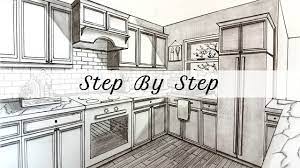
How to Draw a Kitchen Cabinet Layout: Your Comprehensive Guide
Are you eager to embark on a kitchen renovation journey but find yourself puzzled by where to begin? The answer lies in mastering the art of drawing a kitchen cabinet layout. In this extensive guide, we’ll unravel the secrets of crafting a kitchen that not only serves as the heart of your home but also showcases your personal style. With the spotlight on the keywords “how to draw a kitchen cabinet layout” and “how to draw kitchen cabinet layout,” we will walk you through the intricate process of creating a kitchen that’s as functional as it is aesthetically pleasing. Whether you’re a DIY enthusiast or considering professional help, this article will be your trusted companion on this exciting journey.
Understanding the Basics
Before diving into the intricate details of kitchen cabinet layouts, it’s crucial to grasp the fundamentals. A kitchen layout consists of three primary configurations: the U-shape, L-shape, and galley. Each layout has its advantages and drawbacks, depending on your space and preferences.
- U-Shape: Ideal for larger kitchens, this layout maximizes countertop space and allows for efficient workflow.
- L-Shape: Well-suited for smaller kitchens, it optimizes corner space and provides a cozy atmosphere.
- Galley: Common in smaller apartments, it features two parallel countertops with a central walkway.
Taking Accurate Measurements
Before you start designing, you need precise measurements of your kitchen space. Use a tape measure to record the dimensions of your walls, doors, windows, and any other permanent fixtures. This information is crucial for creating a layout that fits seamlessly into your space.
Designing the Layout
Now comes the fun part—designing your kitchen cabinet layout. Consider factors like traffic flow, the work triangle (the path between the stove, sink, and refrigerator), and the placement of essential appliances. Online design tools and software can be incredibly helpful during this phase.
Selecting Cabinet Styles
The style of your kitchen cabinets can significantly impact their overall aesthetics. From classic shaker cabinets to sleek modern designs, the options are vast. Choose a style that aligns with your personal taste and complements your kitchen’s theme.
Optimizing Storage Solutions
Efficient storage is a hallmark of a well-designed kitchen. Explore options like pull-out shelves, deep drawers, and pantry cabinets to maximize your storage space. Customizing your cabinets to suit your needs is a game-changer.
Choosing Countertops and Backsplashes
Selecting the right countertops and backsplashes is essential to create a cohesive look. Materials like granite, quartz, and marble offer durability and aesthetic appeal. Don’t forget to coordinate colors and patterns for a harmonious design.
Lighting and Appliances
Good lighting is vital in a kitchen. Install task lighting under cabinets and consider pendant lights for added ambiance. When choosing appliances, opt for energy-efficient models that match your kitchen’s style.
Reviewing and Refining
Once you’ve drafted your kitchen cabinet layout, take a step back and review it. Make adjustments as needed to ensure a functional and aesthetically pleasing space. Seek input from friends or family for valuable perspectives.
Read more: How to Extend Kitchen Cabinets to Ceiling
FAQs About Kitchen Cabinet Layouts
FAQ : How do I decide on the best kitchen layout for my space?
Choosing the right layout depends on your kitchen’s size and your preferences. U-shaped layouts are great for spacious kitchens, while L-shaped layouts work well in smaller spaces. Galley layouts are perfect for narrow kitchens.
FAQ : What’s the standard height for kitchen cabinets?
Typically, kitchen cabinets are 36 inches high, including the countertop. However, the height can vary depending on your needs and preferences.
FAQ : Can I mix cabinet styles in my kitchen?
Yes, mixing cabinet styles can add visual interest to your kitchen. Just ensure that the styles complement each other for a cohesive look.
FAQ : What are some space-saving storage solutions for small kitchens?
For small kitchens, consider pull-out pantry shelves, corner cabinets with rotating trays, and magnetic knife strips to free up counter space.
FAQ : How can I make my kitchen layout more eco-friendly?
To make your kitchen eco-friendly, choose energy-efficient appliances, use sustainable materials for cabinets and countertops, and install LED lighting.
FAQ : Should I hire a professional designer for my kitchen cabinet layout?
While DIY is an option, hiring a professional designer can ensure a well-thought-out and functional layout that meets your needs and aesthetic preferences.
Conclusion
In the world of home improvement, designing a kitchen cabinet layout is the cornerstone of a successful transformation. By now, you’ve gained a comprehensive understanding of the process, from grasping the basics to fine-tuning the details. Armed with knowledge and creativity, you’re well-equipped to bring your dream kitchen to life. Remember, a well-designed kitchen isn’t just a space; it’s a reflection of your tastes and needs. So, go ahead, take the plunge, and watch as your kitchen evolves into the heart of your home—a testament to your style and functionality.